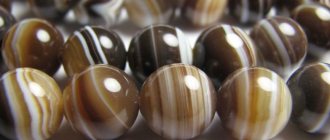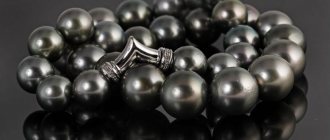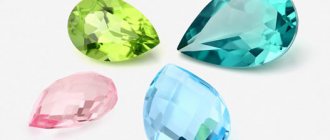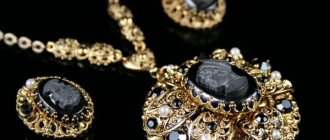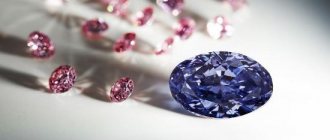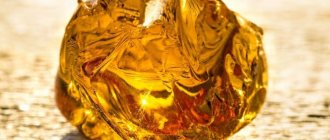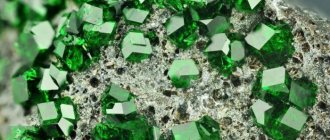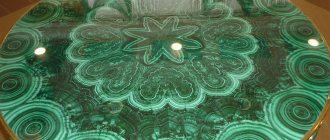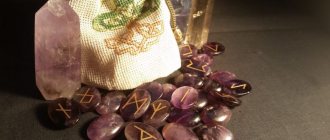Museum of Trade - Commodity Dictionary - Precious and semi-precious stones (Part 1)
Precious and ornamental stones are a wide group of various natural bodies, mainly of mineral and organic origin, which, due to their beauty, decorativeness, hardness and strength, serve as the main decoration of jewelry and material for stone-cutting artistic products, and are also used for various technical purposes. In some cases, the properties of precious and semi-precious stones predetermine the shape and composition of jewelry; in other cases, the choice of stones, their processing and fastening depend on the idea and shape of the product. The main decorative properties of precious and ornamental stones are color, shine, transparency, high refractive index, play of colors and the play of reflected rays that can increase after special processing; the main physical and chemical properties are hardness, chemical resistance, wear resistance.
Precious and ornamental stones are divided into actually precious (gems) - transparent colored or colorless stones with a bright shine, and ornamental - semi-translucent or opaque colored stones. Precious stones are rarely found in nature and require a lot of labor to find, mine and process them; This is the reason for their high cost. Gemstones after cutting are used mainly to decorate jewelry. Some gemstones are produced artificially. Ornamental natural colored stones are used mainly for the production of artistic decorative products - vases, sculptures, etc. (see Stone-cutting products). Along with precious and ornamental stones, substitutes made of glass, plastic and so-called doublets , consisting of a layer of real stone glued to glass, quartz or a stone similar in color to the precious stone, but cheaper. To give stones a brighter color or change color in the desired direction, they are sometimes dyed with various chemical dyes, heated, or exposed to radioactive, X-ray or ultraviolet rays.
Precious and ornamental stones were classified in the USSR into orders, or classes, according to the scheme of Academician A.E. Fersman , which was compiled taking into account the relative value of the stones.
General classification
Among the minerals there are types that are mostly suitable for jewelry. They are classified as semi-precious or precious stones. Others are usually taken for making decorative items. These are ornamental stones. Although they are beautiful, many have interesting colors and natural patterns. After proper processing, such gems also make jewelry and expensive jewelry.
Sometimes jewelry and ornamental stones are additionally distinguished. This is an intermediate group. Crystals are not among the most valuable, but they often make decent jewelry.
Products made from ornamental gems are called stone-cutting. They have been known since antiquity. Every culture has similar artifacts. Craftsmen still make them today. These are various boxes, ashtrays, candlesticks and other items.
Pearl
If all other minerals are found in the bowels of the earth, then pearls are born in the water element. This happens after a grain of sand gets inside the soft tissue of a sea mollusk. To get rid of irritation and scratches, the body of the mollusk begins to envelop the grain of sand with mother-of-pearl. The longer this process continues, the larger and more valuable the jewelry will be.
The cost of a pearl is determined not only by its size, but also by its shape, color, and shine. Sea pearls are also expensive because under their own weight they fall to the seabed, from where it is very difficult to get them. Those pearls in products that can now be purchased in jewelry stores are of artificial origin: grains of sand are planted into the mollusk using tools. To obtain a finished pearl, you need to wait a couple of years, after which it will have a decent size.
Black pearls, which can only be obtained in Tahiti from a certain type of mollusk, are considered especially expensive. However, the most expensive 203-gram pearl was cream-colored, and the price for which it was purchased was $12 million. Its owner and connoisseur was the magnificent Elizabeth Taylor.
The life of a pearl is not as long as that of other precious items: after 100-150 years it begins to fade and loses its pristine beauty.
Popular ornamental stones
The group includes many minerals. Of these, the most popular ornamental stones can be distinguished.
Jasper
Famous gems include jasper. The stone has a large number of colors and shades, and its name translates as “variegated”. The most recognizable are red-brown and green jasper. It is a hard mineral - 7 on the Mohs scale. Consists of silicon oxide and impurities. Opaque. It is found in many countries, but the largest deposits are in Russia.
Nephritis
Another well-known ornamental stone is a mineral called “jade”. This is a legendary gem that is revered in the East. Jade is a hard and viscous mineral. It can be difficult to break off a piece from it. There are different colors; common ones include white, green, gray, and red. Most often there are samples with spots and inclusions.
Quartz
One of the most common minerals on Earth is quartz. A pure stone is colorless. Due to impurities, shades appear, for example, purple, yellow, pink.
Malachite
Another ornamental mineral, malachite, has also been known for a long time - since the times of Ancient Egypt. According to one version, the gem was named after the mallow plant; according to another, the name comes from the Greek word for “soft.” Indeed, stone processing is easy. Hardness -3.5-4 on the Mohs scale. The mineral can be green or its shades. Large reserves have been explored in the Urals and the Republic of Congo (Africa).
Marble
The hardness of marble is 2.5–3 points. Consists of calcium carbonate. Impurities can improve or worsen its quality and decorative properties. White color is often found, but there are specimens with a reddish, black-blue, brown, bluish, greenish color. The pattern sometimes depends on the direction of the cut. All qualities appear after polishing.
Ruby
In order for this gem to form, temperatures above 450°C are required, which is why extensive ruby deposits are located at enormous depths: more than 10-30 km.
The cost of a ruby depends on the color and presence of inclusions. An ideal stone should not contain such inclusions, as they affect the intensity of the surface's shine. In order for a ruby to acquire its beauty, the skill of a jeweler is very important, who can make a beautiful cut, emphasizing the dignity of the mined material.
Magic properties
Ornamental stones serve not only in everyday life or for decoration. Each of them is believed to have magical properties:
- Jasper protects from dark forces and the bad influence of evil people. This is its similarity to agate. Sorcerers loved to store things in jasper boxes. In ancient temples, floors made from this mineral are sometimes found, as it keeps demons out. If you store jasper products in your apartment, the atmosphere of your home improves.
- Jade has rare magical powers . In China, they believe that the gem embodies justice, wisdom, mercy, courage and honesty. The mineral does not like people who harbor negative emotions, so it is recommended to be worn by prepared, spiritually developed individuals. The gem protects from evil, preserves the family and helps in business. However, the thoughts of the owner of the stone must be noble, only then will jade become a good amulet.
- Malachite helps strengthen the connection with the guardian angel and develops intuition . In Ancient Rus' they believed that the gem gave the ability to better understand animals. Malachite is sometimes recommended for children.
Alexandrite
In the 14th century, near Yekaterinburg, a gem with a unique property was discovered: it radically changed its color depending on the lighting.
Alexandrite received its name in honor of Tsar Alexander II, since it was he who was presented with such an unusual mineral as a gift on the day of the crowned person’s coming of age.
The shades and colors that stone can exhibit span a significant portion of the spectrum, from blue-green in sunlight to purple in artificial light. There are very rare specimens with an olive tint.
Scientists explained that alexandrite changes color due to the presence of chromium oxide impurities in it, which refract rays differently. Since this beautiful gem is extremely rare in its pure form, people often try to fake it, which is why most of this material is fake.
Jewelry is practically not made from it, since almost all copies are sold out for collections of precious stones. In addition, alexandrite is credited with medicinal properties, such as purifying the blood and strengthening blood vessels. It is believed that a sudden change in color can indicate a spike in a person's blood sugar levels.
Products with stones
If the mineral is classified as an ornamental one, decorative things are made from it - figurines, boxes, writing instruments. In addition, each of the stones may have its own specific area of application. It depends on the physical, external properties of the gem:
- Even in the Bronze Age, jade was used to make amulets, weapons and much more. The stone is not only hard, but also viscous. Thanks to this, blades made from it are comparable in strength to steel ones. It is of particular importance in the religion of China and for the Maori people (New Zealand). Often used to decorate temples or make sacred objects.
- Marble is familiar to everyone. The mineral is taken for the manufacture of large products: monuments, sculptures, mosaics, floor coverings and wall decor.
- The most widely used material is perhaps quartz. It is part of ceramic objects, glass of the same name is made from it, and is used in optical, radio-electronic and other devices. The application depends on the specific type of this stone. Some, like rose quartz, are suitable for jewelry. Jewelry is also made from other minerals of this group - from jasper, agate, malachite.
Psychics love ornamental stones. Many of these gems are amulets comparable in strength even to black agate. They make amulets and talismans from them.
Ornamental stones have long been popular due to their beauty and natural energy. Jewelry and souvenirs, useful little things and interior items not only please the eye, but also protect the owner from many adversities.
Wedgeclase
This copper arsenate mineral is rare enough to command a high price. It was first discovered in England at the end of the last century and immediately gained popularity for its exotic appearance. Beautiful rosettes consist of intergrown small crystals with a pearlescent or glossy sheen that resemble fantastic blue asters from other planets.
It could have become an ideal material for jewelry, if not for one property: when heated, it begins to emit an unpleasant odor, reminiscent of the smell of garlic, which is why clinoclase is not used in jewelry.
Mosaic art
One of the artistic trends in the use of ornamental stone has become mosaic - creating a single image from small pieces, in this case stones. Precise selection of the shape and color of individual components gives smooth color transitions and clear lines of the overall picture.
Roman mosaic
Art has been known since ancient times, when the Greeks (2nd century BC) were famous for their skill in this field. In the Roman Empire, which was rapidly growing richer and developing during the era of Julius Caesar, Greek craftsmen were invited to work and train apprentices - this is how the technique of Roman mosaics was born on the Apennine Peninsula. At first, the drawings were very simple: a set of geometric shapes and inscriptions. And the material was simple pebbles. But gradually the art of mosaic developed, the technique was honed, and the images became more and more skillful, they were like paintings: colored glass (smalt), marble, limestone, and ornamental stones were added to the pebbles; the seams became thinner, they were filled with paint to match. Mosaic became so widespread that it was used to decorate floors, walls, and ceilings by both ordinary Romans and the richest, and they even used it to pave roads.
Florentine mosaic
Mosaic art received a revival in the Middle Ages in Italy, or more precisely in Florence, hence the name of the new technique - Florentine mosaic. It is distinguished by its high complexity and thoroughness, and at the same time high artistic value. An ideal solid pattern is obtained through skillful cutting and adjustment of stones in size and color, forming images without seams (comesso), with smooth lines and complex shapes, subtle color transitions.
In the 16th century n. e. Ferdinand I of the famous Medici dynasty opened the stone-cutting workshop “Gallery Dei Lavori”, where the first experiments in composing colored stone paintings began. Craftsmen created boxes, game boards, plaques, tabletops, and other furniture elements. Most of all, natural materials were used such as jasper, agate, onyx, marble, chalcedony, quartz, rock crystal - the so-called “pietra dura” (hard stones). For each mineral, a special method of preparation and processing was selected in order to make maximum use of the color capabilities of the material. The art of Florentine mosaic flourished until the 19th century, when people's interest in it faded away, turning to painting and architecture.
Russian mosaic
Russian mosaic is also known, which appeared thanks to M. Lomonosov in the 18th century. It is strikingly different from the Florentine one:
- It is performed not only on flat, but also on curved surfaces;
- On a base of durable inexpensive stone, a pattern of malachite (or other colored stone) plates is glued, creating the impression of a monolith;
- Symmetrical, diverging patterns;
- Sometimes the size is impressive (masters created countertops, doors, columns, entire rooms).
It is worth noting that malachite itself is completely unremarkable in appearance; wonderful natural patterns are revealed when cutting the stone into layers. Ural craftsmen used this stone-cutting technique to work with jasper and lapis lazuli.
Fire opal
The beauty of this gem does not lie in the way the rays of light reflect off it. On the contrary: fire opal seems to absorb light. It looks as if there is a fire burning inside the stone, which gives it a peculiar glow.
This property is ensured by an interesting structure: the material consists of special balls that are frozen in a strictly defined order. The emergence of fire opal occurs at a rate of 1 mm per 2 thousand years. The structure contains up to 1/3 of water, so when heated or over time, it may become lighter due to the evaporation of moisture.
The beauty of this gem attracted people at different times: the Romans associated it with the tears of happiness of the gods, the Indians associated it with the scatterings of the goddess Rainbow, and the Arabs associated it with fragments of lightning. The demand for fire opals has always been great, so they were hunted, they were sought out and people were ready to sacrifice their lives for the sake of possessing these minerals.
Description of gems
Gems are divided into translucent and transparent. The weight of different stones varies from several grams to hundreds of kilograms. For example, the largest ruby weighs 459 g, and topaz crystals can reach a couple of hundred kg.
The color of the stones also varies: expensive diamonds are colorless, like a teardrop, while emerald has a rich shade of fresh greenery. The uniqueness of color, properties, weight and origin makes each precious and semi-precious stone one of a kind, which jewelers successfully use when making unique jewelry.
Diamond
This stone is most often used to decorate wedding rings all over the world. Diamond consists of a single element in the periodic table – carbon. Until now, scientists cannot come to a consensus on when and how exactly this mineral was formed, since formation requires the highest pressure and temperature. These conditions are met at great depths, but the stone is found on the surface. The age of each diamond ranges from 900 million to 2.5 billion years. Their density is so high that a ray of sunlight while passing through the crystals reduces its speed by half.
Diamond is stolen more often than other jewelry in all banks in the world, and the largest number of crimes is associated with it. The last high-profile robbery occurred in 2007, when a thief gained the trust of bank employees by periodically treating them to chocolate. The value of the diamond that he was able to steal from the safe is $28 million.
In addition to the transparent stones that are familiar to us, which have no color, there are also green, blue, yellow, red and pink diamonds, which are valued even more. The red diamond is considered the most beautiful: a couple of years ago, a specimen weighing 0.97 carats was purchased for 1 trillion. dollars.
Hackmanite
The rarest variety of minerals from the sodalite rock. More often than not, hackmanite is the pride of collectors. But it is also used as a gemstone for jewelry.
Hackmanite
Informative: the highlight of hackmanite is tenebrescence (photochromism). This is the property of a stone to change color under the influence of ultraviolet radiation (whether it is the Sun or a UV lamp).
The color changes from pink to purple.
It is impossible to counterfeit hackmanite.
Tourmaline
One of the most coveted pieces in any private collection is a stone with a huge range of colors and iridescences. This mineral was a favorite among crowned persons, so many representatives of royal regalia from Russian emperors and European rulers to Tamerlane were its fans.
There are single-color or polychrome forms, in which different colors are alternately combined, or there may be clumps with a colored core. When heated strongly, tourmaline becomes even more beautiful: brown specimens turn into rich pink, and dark green specimens acquire a noble emerald color. Tourmaline has an interesting feature: when heated or rubbed, it becomes electrified.
This mineral became especially popular thanks to the great jeweler Faberge: when inlaying his works, he often preferred tourmaline, which can still be seen on most of the jewelry he created.
comments
Darina Despite the fact that synthetic or artificial stones now predominate, precious stones will never be left without attention, naturally, and their price is much higher.
For me, a beautiful and favorite stone that I can afford is ruby. Anita We found, or rather learned recently about such an interesting little-known or unknown stone Khantigirit from Khakassia - it protects so much from vampires and sorcerers, dear mother. Here!
Sergunya Hello! In Kharkov, at an exhibition, I bought myself one. Power!!!!!!
Only in Siberia
The only deposit of charoite in the world lies on the watershed of the Tokko and Chara rivers.
Charoite deposit in Yakutia
Wild taiga. Border of the Irkutsk region and Yakutia. The area is earthquake-prone. A thousand off-road kilometers to some civilization. One and a half thousand meters above sea level. And only 10 km 2 is the area of the deposit. And even then it does not represent a solid massif, but is fragmented into 20 (approximately) sections.
Russia, near Yakutia and Irkutsk region
Surprisingly, under such mining conditions, the price of charoite is not at all prohibitive. It cannot be compared, for example, with the same tanzanite.
And the deposit is called poetically - Lilac Stone (Murunskoye).
Expert opinion
Semenishcheva Polina
Specialist in mineralogy. Graduated from St. Petersburg Mining University.
Charoite is mined using a quarry method, without resorting to explosions. They would destroy most of the expensive stone.
Grandidierite
Until recently, it was considered one of the rarest jewelry stones. It was discovered in 1902 in Madagascar. Its beauty and rare property - trichroism - place it among the best precious stones. The gem radiates three colors at once: colorless, blue-green, green, and twilight dark.
Grandidierite
In the 100 years since its discovery, less than 20 gems suitable for cutting have been found. In 2014, a deposit of gem-quality grandidierite was discovered in Madagascar.
Gems are occasionally found in:
- Canada;
- India;
- Japan:
- Algeria.
But the highest quality stones can only be found in Sri Lanka and Madagascar.
| Category | Silicate minerals |
| Title in English | Grandidierite |
| Formula | MgAl3O2(BO3)(SiO4) |
| Group | Group of precious stones |
| Color | Blue; green |
| Stroke color | White |
| Shine | Glass, Mother of pearl |
| Transparency | Translucent, Transparent, Translucent |
| singonia | Rhombic |
| Hardness | 7 — 7,5 |
| Cleavage | Perfect |
| Density, g/cm³ | 3 |
| Kink | Fragile, Uneven |
Average quality grandidierites sell for $2500-3000 per carat. Premium stones can cost up to US$50,000 per carat.
Taaffeit
One of the rarest minerals in the world. Named after the discoverer.
Taaffeit
The colors of the stone range from pale pink to lavender.
| Formula | Mg3Al8BeO16 |
| IMA status | Valid |
| Taxonomy according to IMA (Mills et al., 2009) | |
| Class | Oxides and hydroxides |
| Subclass | Complex oxides |
| Supergroup | Högbomita |
| Group | Taaffeita |
| Color | Colorless, greenish, mauve |
| Shine | Glass |
| Transparency | Transparent to translucent |
| Hardness | 8 — 8.5 |
| Fragility | Fragile |
| Cleavage | Imperfect |
| Kink | Conchoidal |
| Density | 3.6 g/cm³ |
Gems are occasionally found in placer deposits in Sri Lanka and southern Tanzania.
The authenticity of the gem helps determine the effect of double refraction of color.
The cost of crystals is from 2000 to 10,000 US dollars per carat.

